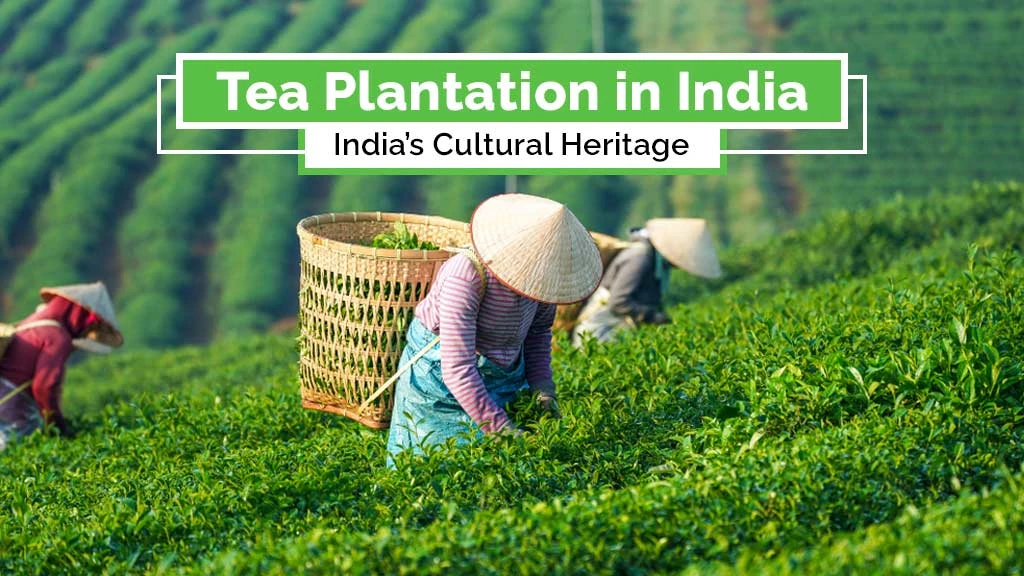Tea Plantation in India: India’s Cultural Heritage

Table of Contents
- What is the Origin of Tea Plantation in India?
- What is the Present Status of Tea in India?
- What are the Popular Tea Varieties in India?
- What are the Steps Involved in Tea Cultivation?
- Which are the Top Tea Producing States in India?
- What is the Status of Indian Tea Exports?
- What are the Government Initiatives to Support Tea Production in India?
What is the Origin of Tea Plantation in India?
Tea is one of the most consumed beverages in India. Tea is not native to India, but it has become integral to Indian society and culture. The Britishers introduced tea plantations in India in Assam’s Brahmaputra Valley in the early 1800s from China on the recommendations of Sir Joseph Banks in 1776. The tea seedlings that were sown then went on to create a vast tea empire by the time India attained independence in 1947. As of 2019, India boasts nearly 1600 tea gardens, with maximum in Assam and cultivation of 8 tea varieties, with Darjeeling tea being the most prominent.
What is the Present Status of Tea Cultivation in India?
India has a diverse geography and a rich cultural heritage suitable for tea cultivation. Today, India is the second largest tea producer after China, the largest producer of black tea and the 4th largest exporter of tea in the world.
As per the latest data from the Tea Association of India, the total area under tea cultivation stood at 6.19 lakh hectares, and the total tea production stood at 1394 million kgs. India is also among the world's top tea-consuming countries, with 83% of the tea produced in the country consumed by the domestic population. The domestic consumption of tea stood at 1215 million kgs.
The tea industry plays an important role in India’s economy, providing employment to around 2 million people, particularly in the rural areas of tea estates. The top tea-producing states in India are Assam, West Bengal, Kerala, Tamil Nadu and Karnataka.
What are the 8 Major Tea Varieties in India?
- Darjeeling
- Assam
- Nilgiri
- Kangara
- Dooars-Terai
- Masala Tea
- Sikkim Tea
- Tripura
According to ICAR, the following districts or regions got GI tags for tea plantations in India:
|
Tea Varieties in India |
States |
|
Darjeeling Tea |
West Bengal |
|
Kangara Tea |
Himachal Pradesh |
|
Nilgiri Tea |
Tamil Nadu |
|
Orthodox Assam Tea |
Assam |
What are the Steps Involved in Tea Cultivation?
Soil & Climate Requirement
Tea cultivation requires well-drained soil with a high amount of organic matter. The presence of minerals like potassium, phosphorus, and nitrogen is crucial for healthy tea bushes. Tea cultivation needs an ideal pH between 4.5 and 5.5. The temperature may vary from 16°C to 32°C, and annual rainfall should be 125 cm to 150 cm, which is well distributed over 8-9 months in a year. The performance of tea is best at elevations ranging from 1000 m to 2500 m.
Season and Plantation
The best season for tea plantations in India is May - June or September – October for South-West and North-East monsoon areas. In the plantation process, the sleeves should be opened lengthwise without injuring the roots and planted in the pit, and the soil should be gently pressed. Nowadays, a single-hedge or double-hedge contour planting system is followed.
- Single Hedge System - In this method, the spacing adopted is 1.20 m x 0.75 m, accommodating 10,800 plants per hectare.
- Double Hedge System - In this method, the spacing adopted is 1.35 m x 0.75 m x 0.75 m, accommodating 13,200 plants per hectare.
Irrigation and Manuring
- Subsoil irrigation may be given to the young tea seedlings in the months of the summer season.
- The process of manuring should take place after 2 months of plantation. Fertilisers should be applied before the onset of the monsoon season.
Training and Pruning
Training and pruning are essential steps in the cultivation of tea. In the young tea plant, the growing point, leaving 8 to 10 mature leaves from the bottom, is removed to induce secondaries. Pruning is done to:
- maintain convenient height for plucking.
- get more vegetative growth.
- remove the knots and interlaced branches.
- remove dead wood and branches.
Rejuvenation pruning, Hard pruning, medium pruning, Light pruning and Skiffing are some common types of pruning practiced in India.
Pest and Disease Management
|
|
Pests and Diseases |
Symptoms |
Control Measures |
|
|
Tea mosquitoes (Helopeltis antonii) |
|
|
|
|
Shot-hole borer (Xyleborus fornicatus) |
|
|
|
|
Red spider mite (Oligonychus coffeae) |
|
|
|
|
Blister blight (Exobasidium vexans) |
|
|
|
|
Black root diseases (Rosellinia arcuata) |
|
|
Harvesting
Plucking consists of harvesting 2 to 3 leaves and a bud. In India, a tea plantation is a labour-intensive operation that decides the tea's yield and quality. The duration of the tea crops gets old after 3 years. During the rush period, the harvesting of the crops is done at an interval of 7-10 days, whereas during the lean period, harvesting is done at an interval of 10-15 days.
Which are the Top Tea Producing States in India?
|
States |
Production in 2023 (in million kilograms) |
|
Assam |
688.33 |
|
West Bengal |
433.54 |
|
Tamil Nadu |
167.40 |
|
Kerala |
63.75 |
|
Karnataka |
5.53 |
What is the Status of Indian Tea Exports?
According to the Tea Board of India, India is among the world's top 5 tea exporters, making about 10% of the total exports. India's total tea exports during 2023-24 in quantity were 250.73 million kg and worth US$ 776 million. During the 2022-23 period, India exported tea in the quantity of 228.4 million kg, which was worth US$ 765 million. India exports to more than 25 countries of the world and the top export destinations during 2023-24 were Iran, the UAE and Russia.
Indian Assam, Darjeeling, and Nilgiri tea are considered one of the finest tea varieties in the world. The majority of the tea exported out of India is black tea, which is about 96% of the total exports. The following are the types of tea exported through India:
- Black tea
- Regular tea
- Green tea
- Herbal tea
- Masala tea
- Lemon tea
Out of these, black tea, regular tea, and green tea make up approximately 80%, 16% and 3.5% of the total tea exported from India respectively.
What are the Government Initiatives to Support Tea Production in India?
The Indian Government has launched a Tea Development and Promotion Scheme to promote tea production in India. This scheme was launched in November 2021 by the Tea Board of India for 2021-26. This scheme aims to enhance the productivity and quality of tea production in India. The government is helping farmers by providing the following benefits in terms of financial assistance -
- The government is providing subsidies for equipment such as a pruning machine, mechanical harvester, brush cutter, etc., @ 25% of the actual cost of the equipment.
- To obtain organic certification or renew the certification, the government is providing 50% of the cost of the accreditation empanelled by the tea board/APEDA under the National Program for Organic Production (NPOP).
- To set up a factory, the government assists by FPO at 40% of the actual cost with a ceiling limit of Rs. 2 crores/factory.
There are seven essential components to this scheme:
- Plantation development of small tea farmers
- Worker's welfare
- Creation of sector-specific action plan for North East India
- Research and development activities
- Supporting the tea producers and traders in market promotion activities
- Regulatory reforms
- Establishment expenses
In conclusion, India’s tea industry is paramount in promoting agricultural diversity and cultural heritage. States like West Bengal, Assam and Tamil Nadu contribute unique flavours and characteristics to the vast array of Indian teas. The government is giving subsidies to farmers for equipment such as pruning machines, mechanical harvesters, brush cutters, etc. Farmers are getting more employed and earning additional income through tea plantations in India.
Frequently Asked Questions On Tea Plantations in India
1. Is tea plantation profitable?
Yes, tea plantations have a benefit to cost ratio in the range of 1.2 to 2.2.
2. Which soil is most suited for tea plantation?
The tea plantation is done best in deep and fertile, well-drained laterite soil.
3. Why are hillslopes best suited for tea plantations?
Hillslopes are best suited for tea plantations as they have proper drainage facilities and prevent water from logging.
4. Are green tea plantations the same as regular tea?
Yes, all of the tea comes from the same plant. Like, black tea is oxidised, and the green tea is not oxidised.
5. What is the temperature and climate required for a tea plantation?
The best temperature to grow tea is hot and humid. The temperature required for tea plantations is 18℃ to 30℃.
6. Where are tea plantations found in India?
Assam, Tamil Nadu, West Bengal, and Kerala are India's largest tea-producing states. Along with this, other states also produce tea, but not in vast quantities.
7. Which method of irrigation is used in tea plantations?
Drip irrigation is a method considered the best for tea plantations.


Related Blogs















